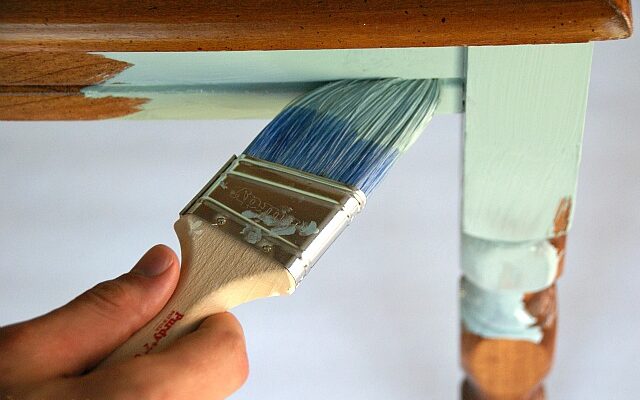First and foremost, it’s critical to understand what chalk paint is and how it differs from other options. The market is flooded with various chalk paint brands, each with its unique formulations, but they all have a matte finish and a thick, chalky consistency that adheres well to wood and other surfaces.
What are the composites of chalk paint?
The appearance of chalk paint varies from brand to brand. However, the majority of chalk-based paints are water-based. Chalky paint is composed of two components: a binder that aids in adhesion to the surface and an aggregate that imparts the paint’s gritty, sometimes powdery texture. In the case of painting with homemade chalk paint, the aggregate is frequently made of plaster of Paris, baking soda, or unsanded grout, among other things. In addition to the coloring that gives it the specific shade, it is typically low in volatile organic compounds (VOCs) (volatile organic compounds).
What is the purpose of chalk paint?
Using chalk paint to paint furniture, small projects, and crafts have become one of the most popular methods of painting furniture. It aids in creating a farmhouse style with painted furniture and shabby chic home decor, and it can be achieved through the use of various techniques such as dry brushing, blending, and antiquing.
In what way does chalk paint differ from regular painting?
Surfaces with no possibility of stain bleeding through, paint that does not have a lot of sheens, and where you intend to apply a protectant coat on top of the chalk paint will adhere to surfaces well with chalk paint. In addition, the grit or chalkiness of the product allows it to adhere to surfaces such as raw wood furnishings. Unfortunately, even though it adheres well, it does not provide adequate protection or a smooth, flawless finish on your family antique.
Chalk paint doesn’t require any surface work.
To ensure that the paint adheres to a piece of furniture, you must first sand it to a sufficient degree of grit or tooth on the surface. However, due to the porous nature of chalk paint, sanding can sometimes be avoided when painting furniture with it. This is because chalk paint has some glue-like properties.
Most people imagine themselves working in the fields over a large piece of furniture for hours on end with a small piece of sandpaper in their heads. That doesn’t seem in the least bit appealing, which is why an electric mouse sander is used to accomplish the same thing.
If you’re sanding furniture, the goal isn’t to completely remove the paint from the piece’s surface. Just lightly go over the surface with your finger to give it a rough texture, aiding in the paint adhesion.
Is it necessary to sand before using chalk paint?
If you are using chalk paint on stained wood furniture, sanding the surface is recommended first to make it more porous so that the paint adheres better. On raw wood, you can get away with painting with chalk paint without sanding, but even then, there will likely be splintered edges that you’ll want to sand out before painting.
When it comes to applying chalk paint to wood furniture, most furniture pieces must be sanded before painting them.
Chalk paint doesn’t require any priming to be used.
There is a learning curve for waxing, and it can be a time-consuming process that requires patience. Additionally, after your clear wax has dried, you may want to apply a layer of dark or white wax for decorative purposes. When you use chalk paint, the time you save on sanding and priming will be spent waxing your piece, which will save you even more time. Furthermore, it takes a full month for a thin coat of wax to cure before a piece is sufficiently protected from being used or sold. A clear coat will dry in a couple of hours or a little longer if you’re working in high humidity, depending on the temperature.
Even when chalk painting furniture, there are times when you will need to use a primer because many dark stains will bleed through to the other side of the furniture.
Additionally, a primer is beneficial for providing coverage. For example, if you were to paint Old White chalk paint on black furniture, it would take several coats of chalk paint to completely cover the piece; however, using a primer will reduce the number of coats required, saving you time, energy, and the additional cost of chalk paint.
Is it necessary to seal chalk paint?
When you chalk paint furniture, you must always use a soft wax or protective finish to keep the surface from becoming scratched.
Every painted piece of furniture must be coated with a substance that will adhere to the surface while also protecting the piece over time. Unfortunately, no single product does both things exceptionally well – at least not in a cost-effective manner. Chalk paint may have good adhesion properties, but it may not provide the level of protection you desire. Latex paint provides protection, but it does not adhere to the surface.
If you don’t wax your chalk paint, what will happen?
When a cold beverage is left on an unwaxed piece of furniture, what happens to the piece’s surface? Chalk paint re-solidifies when it is heated. Your cold, sweet tea can be seen on the entry table you refinished last year when your family came over. The next morning, you can see soggy stains on your prized possession.
You also need to make sure that you apply the wax evenly. If you don’t apply the wax evenly to chalk paint, dirt is attracted to the excess wax. Make sure to use coasters on items that are frequently used.
Chalk-painted furniture requires re-waxing every three years or more frequently if in heavy use. This is because the wax finish will degrade with time. If you use latex paint, you won’t have to do any more maintenance than a quick wipe down now and then with a soft cloth.













Comments